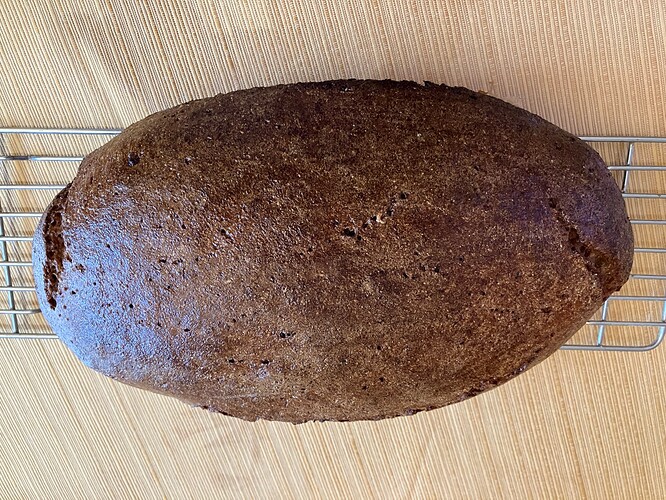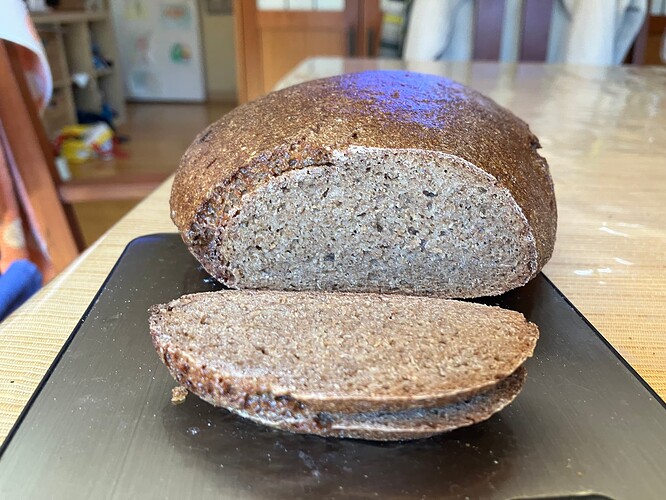Thank you both. Glad to hear I don’t need to toast it! Should I attempt to hold the scald at a warm temperature or is it really not necessary?
This recipe has a scald and rye breads can always benefit from one. Scald at 65C if you have the means to measure the temperature of the water.
This bread is EXCELLENT. I waited 5 hours rather than 24 to cut off a few end slices. Not gummy at all. Sort of a pain to make it but well worth it. I followed the recipe exactly but did add whole caraway seeds. Next time I’ll scale up to make a larger loaf. Thank you!
You’re welcome. I love it too. Great idea to scale up.
Side note: I’ve now tried it as 100% rye and with the 50g bread/ap flour of the original Stanley Ginsberg recipe, and I prefer the slight lift and extra chew added by that small amount of refined flour.
Bursts along the edges can be do to excess water at the edge between the dough and base. If you get this, make sure this contact edge is dry. If you can see the stages of how rye falls apart then you can see that moisture makes this happen. Rus brot has an essay on what causes rips and how to fix them if you can find this, you’ll understand better .
Thank you, Corvus Corax! This must be the blog post you mentioned: Хлебные закваски: Как испечь ржаной хлеб без подрывов There are many tips I’m looking forward to trying from this post. It’s interesting that he recommends against using steam for a rye bread with a smooth crust. That, at least, will be very easy to implement. I will be mindful of your advice about excess water at the edge as well.
As Mr. Andrei says, incorrect moulding of the dough can lead to this. Watching his videos, you can see how the seams of his rye breads are on the bottom of the bread and do not touch the sides or edge of the bread. Too high a hydration can cause the rips too and what is the hydration should be is very flour dependent; I have two sources of rye berries and one can accept a higher hydration than the other and the difference is only 5%. Too low a hydration causes a door stopper, too high a rip. I see that you are coating your rye with a mix of flour and water but as A. suggests, use a piece of dough diluted with water and ferment it like the main dough. I use scrap 25g of dough after the final moulding and then diluted it with 20g of water and really mix this up and ferment it with the final proofing of the dough. When you put it on the dough ready for oven, just be careful not to get it on the edge . I bake of a pizza stone, no steam and steaming can cause the rips too, and the oven gets to 450 degrees F tops, so you don’t need to go any higher. I hope this helps.
Let me know how you make out with this. I might suggest try the hydration of the rye around 70% and if it is a door stop with no rips, you just need to adjust up the hydration by 5% and try again. For me, one rye takes 70% and the other takes 75%.
Delectable bread! Thank you for the recipe and level of details!
We visit family in the Baltic Sea region once a year. After baking, it was difficult to not cut into the bread with that familiar aroma of rye bread for 24 hours. Mine has cracks on top and to the side.
This is very good flavor rye bread. I used home milled sprouted rye (I don’t have unsprouted rye) and I did scald the rye berries. Mine isn’t anywhere near to color of Melissa’s loaf, but I am happy with the bread. I will bake this again.
Thank you again for the recipe!
Best,
A
I have been implementing all the suggestions you gave last year and getting some better results—thanks!! Lowering the hydration is my next experiment. My question here is whether I should be aging freshly-milled rye flour for a couple of weeks, effectively lowering the hydration that way, before I start reducing liquids? I’ve never seen a definitive answer to this question, though it seems like it could actually matter in a recipe with such a fine hydration tolerance.
I would not bother–the flour may be different and work better but what is lasting value is to get a feel for the dough when it has the right hydration. Learn this and free yourself so you get the results you want-no matter the flour.
If I were able to get my hands on some solod, would I substitute 1:1 for the sprouted rye flour in the scald in your recipe?
Sweet! I have solod too these days and keep it in my freezer. It is so good in this bread. Yes, use 35 grams.
Thank you for your quick reply!
What temperature is the oven when the bread goes in?
The oven temp is at 350F when the dough goes in. Then you shut the door and set the oven to 445F immediately.

